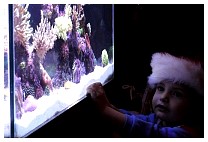 Tank of the Month
Tank of the Month
Tank of the Month
Thodoris Stoidis's (teo reef) Reef Aquarium
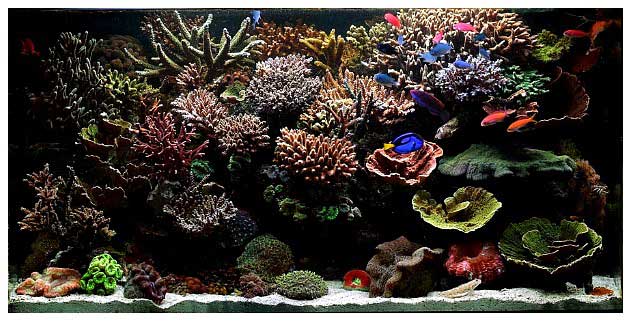 |
Introduction:
I feel very fortunate and happy to have the opportunity to present my little treasure to you, here at the Pantheon of Reefs. After many years of keeping a freshwater aquarium with African cichlids, and later with Discus, I finally ended up in the wonderful world of reefs. I am fascinated with the numerous colors of the reef, its vast diversity and the development of organisms through time. My passion and love for reefkeeping outweighs the expense, and my exhaustion from the countless hours I spend over my tank, soaking my hands. It brings me great satisfaction to enjoy my reef after work, together with family and friends. Here in Salonica, Greece it is difficult to find a large variety in corals and fish. However, there are many people here trying to raise the level of the hobby to that of other European countries and the US.
How I Started:
It all began in the autumn of 2006 with a 50-gallon tank. I started with some soft corals and large-polyped stony corals (LPS). Soon, small-polyped stony corals (SPS) stole my heart and gained a prominent place in my aquarium. Over time, the corals grew so prolifically that there was not enough room for my fish to swim, and it was difficult to do necessary maintenance on the tank. I decided to exchange the 50-gallon tank for my current 80-gallon tank. Since there was not enough room under my stand to include a sump, I constructed a do-it-yourself (DIY) hang-on-back refugium.
System Profile:
Main Tank: 80-gallons - 105 x 53 x 58 cm (41 x 21 x 23 in)
Filtration: Two Deltec MCE 600 skimmers
Lighting: Two 150-watt HQI + five 39-watt T5s (two are dimmable)
Calcium reactor: Schuran Jetstream Pico Twice with 5kg CO2 bottle and Papillion CO2 controller
Circulation: Tunze Turbelle 6100 and 7240 connected to Tunze single-controller
Nanostream 6045
Two 6025 (modified to increase output to ~6000 l/h)
Chiller: Atman CS-250
Other: DIY hang-on refugium with Zeovit reactor attached to it.
Tunze Osmolator
pH monitor Weih Pro
Eliwel temperature controller
Eheim 2028 (mechanical filtration)
Sander Ozonisator (100mg/h)
Filtration:
Due to limited space under the stand, I was not able to benefit from the use of a sump. I had to find a different way to filter the water effectively, with the least visible equipment. On the back side of my tank I have two Deltec MCE 600 skimmers set to “wet” skimming. In my first tank, I used one MCE 600, but when I moved to the 80-gallon tank, I felt I needed one more skimmer to deal with the heavy stocking bioload. Furthermore, I added an acrylic hang-on refugium, in which I keep Chaetomorpha algae, in order to provide a constant supply of live copepods to my fish, as well as for efficient nutrient export. When I started using the Zeovit method, I had my refugium modified so I could attach a Zeovit reactor. Calcium and alkalinity are provided by a Schuran Jetstream Pico Twice reactor using a 5kg CO2 bottle and controlled with a Papillion CO2 controller.
Lighting:
During the first few months of reefkeeping, I only used T5 bulbs to light the tank. The LPS and soft corals seemed to be doing pretty well. After the first SPS corals were introduced, I increased the wattage by changing out the T5 Luminaire fixture with a new Jalli model, with two 150-watt 14000K bulbs and two T5 bulbs. Three more T5s were added later to enhance actinic light and give the SPS a brighter color. My T5 lamp combination consists of one Korallen Zucht Fiji purple, one Korallen Zucht New Generation, one Arcadia Marine White, one Giesemann Aquablue Plus and one Giesemann Pure Actinic. The Giesemann Pure Actinic and Korallen Zucht New Generation are connected to a do-it-yourself dimmer.
|
Photoperiod:
|
Reverse Osmosis Units:
My aquarium is supplied with pure water by a 7-stage 100-gallon reverse osmosis (RO) filter unit, checked often with a TDS meter to ensure that my water is 100% pure. I also use another 6-stage 50-gallon AquaMedic RO unit which is controlled by an electronic valve and fills the Osmolator tank when needed.
Zeovit and Water Parameters:
In September 2008, I incorporated the Zeovit method into my system. This method is known for the bright colors it imparts to the corals, particularly SPS. It creates a low nutrient environment similar to that of a natural reef ecosystem. In this way, levels of zooxanthellae in SPS are controlled, promoting vivid colors. The main elements of Zeovit are the zeolites, some amino acids, and bacterial food. Zeolites, which are basically man-made rocks to absorb reef toxins, are placed in the Zeovit reactor under a specified flow. I adjust the flow using an external Eheim 2028 canister filter that is also used for mechanical filtration. A film, which is believed to be a premium coral food, is then created on the zeolite’s surface. By exposing the zeolites to water flow, the film is then released into the tank. The Zeovit supplements I use include: Zeo-bak, Zeostart2, Zeofood7, Pohl’s Xtra, Coral Vitalizer, B-balance, Amino LPS and Sponge Power. My Zeovit routine also includes a 10% water change every week with Reefer’s Best Coral Reef salt and a carbon change every 20 days. I place carbon in my refugium under gentle flow.
|
Water Parameters:
|
Feeding:
My favorite time to enjoy my tank is when I am feeding. I feed my fish three times a day: at noon they are given flake food, Cyclop-Eeze in the afternoon (for my anthias), and late at night, frozen food. Every portion is quite small in order to avoid raising the nutrients in the tank. My favorite manufacturer of flake and frozen food is Ocean Nutrition, especially frozen lobster eggs and Mysis shrimp. I moisten these with Seachem garlic and Selcon vitamins prior to feeding. Two to three times a week I also target feed most of my corals with a mixture of Kent Zoomax, Kent Phytomax, Kent Chromamax, Cyclop-Eeze and various frozen foods.
SPS Corals:
|
Acropora:
|
|
Montipora:
Stylophora pistillata, Seriatopora hystrix, Seriatopora guttatus, Hydnophora lamellosa, Hydnophora exesa, Pocillopora damicornis, Pocillopora verucosa. |
LPS Corals:
Caulastrea furcata, Caulastrea curvata, Euphyllia divisa, Euphyllia parancora, Trachyphyllia geoffroyi, Scolymia vitiensis, Tubastrea aurea, Lobophyllia hemprinchii, Lobophyllia robusta, Platygyra daedalea, Blastomussa wellsi, Fungia repanda, Favites speciosa, Favites bestae, Acanthastrea lordhowensis.
Other Corals:
Ricordea florida, Ricordea yuma, Actinodiscus sp., Clavularia sp., Protopalythoa sp., Pachyclavularia violacea, Zoanthus sp.
Fish:
|
|
Invertebrates:
|
|
Future Plans:
This fall and winter, I am going to start my new project: a 125-gallon tank with a frag farm and a sump in the stand. Everything is going to be built from scratch, and I will purchase new, cutting-edge equipment. Everything has been designed in detail, especially the new aquascape, which has intrigued me to upgrade my current tank to a larger size. More details, information and photos coming soon.
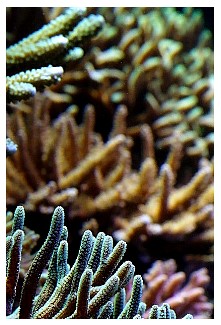 |
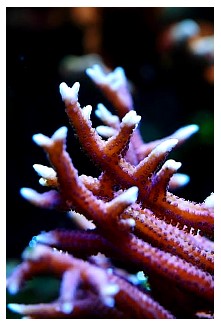 |
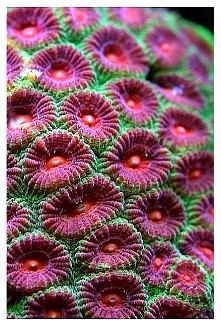 |
Concluding Thoughts:
|
Over time, I have observed the amazing growth and development of the corals in my reef. Corals that started out as stable and colorless for more than a year have doubled their size and changed color in just two - three years. In my opinion and experience, the key to successfully maintaining SPS corals in the aquarium is providing stable water parameters, especially carbonate hardness, a high pH value and, of course, keeping to a consistent maintenance routine.
Acknowledgements:
A great reef cannot be created very easily without spending many hours of reading and discussing with like-minded, reef-passionate people. That’s why I want to say a big "Thank you!" to Reef Central and Reefkeeping Magazine, who gave me this opportunity to become a more conscientious and knowledgeable reefkeeper. I would also like to thank my friends in Greece who helped and encouraged me to achieve this nomination. Many thanks to Z_X for his magnificent photos, Vasilakis, Neoklis, Billy, Madfdg and of course, www.openreef.gr for its support.
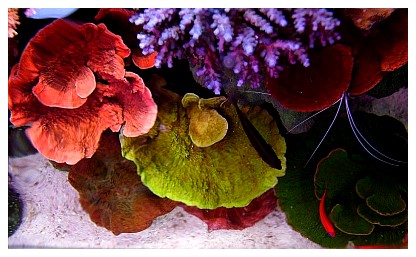 |
Feel free to comment or ask questions about my tank in the Tank of the Month thread on Reef Central.




